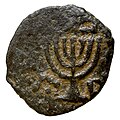Menorah (Temple)

The menorah was an ancient lamp that accompanied the Israelites during their wanderings through the desert and later sat in their Temple. It had seven branches (a center branch with three branches on each of its sides), and it was made of gold. Olive oil fed the menorah's flames. God commanded Moses to construct the menorah while Moses and the Israelites were wandering the desert (see Book of Numbers chapter 8).
The menorah is associated with miracles, such as the miracle of Hanukkah. During First Jewish-Roman War, the Romans destroyed the Temple and took its treasures, including the menorah. They took the menorah to Rome and displayed it throughout the city during a celebration of their victory over the Jewish rebels.
Today, the menorah is featured in the present state of Israel's coat of arms, and some Jewish places of worship contain replicas of the menorah. A nine-branch menorah is used during Hanukkah.
Menorah (Temple) Media
Early representation of the menorah, on a coin coined by Antigonus II Mattathias, the last Hasmonean king of Judea (r. 40–37 BCE)
Depiction of the menorah on the Arch of Titus in Rome
Destruction of the Temple in Jerusalem by Francesco Hayez. The menorah is carried away by Roman soldiers, on the bottom-left corner. Oil on canvas, 1867.
Painting on Genseric sacking Rome by Karl Bryullov (1833–1836), depicting the menorah taken away by the Vandals.
Seven-branched menorah, Eshtemoa synagogue (4th–5th century CE). Rockefeller Museum
19th century Hanukkah menorah from Austria-Hungary. Musée d'Art et d'Histoire du Judaïsme








